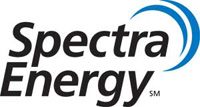Enbridge Inc. is a Canadian multinational pipeline and energy company headquartered in Calgary, Alberta, Canada. Enbridge owns and operates pipelines throughout Canada and the United States, transporting crude oil, natural gas, and natural gas liquids, and also generates renewable energy. Enbridge's pipeline system is the longest in North America and the largest oil export pipeline network in the world. Its crude oil system consists of 28,661 kilometres of pipelines. Its 38,300 kilometre natural gas pipeline system connects multiple Canadian provinces, several US states, and the Gulf of Mexico. The company was formed by Imperial Oil in 1949 as the Interprovincial Pipe Line Company Limited to transport Alberta oil to refineries. Over time, it has grown through acquisition of other existing pipeline companies and the expansion of their projects.
Puget Sound Energy (PSE) is an energy utility company based in the U.S. state of Washington that provides electrical power and natural gas to the Puget Sound region. The utility serves electricity to more than 1.1 million customers in Island, King, Kitsap, Kittitas, Pierce, Skagit, Thurston, and Whatcom counties, and provides natural gas to 750,000 customers in King, Kittitas, Lewis, Pierce, Snohomish and Thurston counties. The company's electric and natural gas service area spans 6,000 square miles (16,000 km2).

TC Energy Corporation is a major North American energy company, based in the TC Energy Tower building in Calgary, Alberta, Canada, that develops and operates energy infrastructure in Canada, the United States, and Mexico. The company operates three core businesses: Natural Gas Pipelines, Liquids Pipelines and Energy.

Atmos Energy Corporation, headquartered in Dallas, Texas, is one of the United States' largest natural-gas-only distributors, serving about three million natural gas distribution customers in over 1,400 communities in nine states from the Blue Ridge Mountains in the East to the Rocky Mountains in the West.

The Williams Companies, Inc., is an American energy company based in Tulsa, Oklahoma. Its core business is natural gas processing and transportation, with additional petroleum and electricity generation assets. A Fortune 500 company, its common stock is a component of the S&P 500.
The Mackenzie Valley Pipeline, also called the Mackenzie River Pipeline, was a proposed project to transport natural gas from the Beaufort Sea through Canada's Northwest Territories to tie into gas pipelines in northern Alberta. The project was first proposed in the early 1970s but was scrapped following an inquiry conducted by Justice Thomas Berger. The project was resurrected in 2004 with a new proposal to transport gas through the sensitive arctic tundra. Probabilistic estimates of hydrocarbons in the Mackenzie Delta and Beaufort Sea regions project that there are natural gas reserves of 1.9 trillion cubic metres. After many delays, the project was officially abandoned in 2017 by the main investment partners citing natural gas prices and the long regulatory process.
Questar Pipeline Company (QPC) provides natural gas transportation and underground storage services from the Rocky Mountains region. Its FERC code is 55. Questar Pipeline is a subsidiary of Questar Corporation. Questar Corporation was acquired in 2016 by Dominion Energy.
Transwestern Pipeline Company, LLC owns and operates a natural gas transmission system that connects natural gas supplies in the San Juan and Rocky Mountain Basins in northwest New Mexico, southwest Colorado, the Texas-Oklahoma Panhandle, and the Permian Basin region of West Texas and Southeastern New Mexico with California, Arizona, Nevada in the West and Texas, and New Mexico on its Eastern end. Transwestern is a "natural gas company" as defined under the Natural Gas Act and is regulated under the rules and regulations of the Federal Energy Regulatory Commission.

Kinder Morgan, Inc. is one of the largest energy infrastructure companies in North America. The company specializes in owning and controlling oil and gas pipelines and terminals.

Petroleum production in Canada is a major industry which is important to the overall economy of North America. Canada has the third largest oil reserves in the world and is the world's fourth largest oil producer and fourth largest oil exporter. In 2019 it produced an average of 750,000 cubic metres per day (4.7 Mbbl/d) of crude oil and equivalent. Of that amount, 64% was upgraded from unconventional oil sands, and the remainder light crude oil, heavy crude oil and natural-gas condensate. Most of the Canadian petroleum production is exported, approximately 600,000 cubic metres per day (3.8 Mbbl/d) in 2019, with 98% of the exports going to the United States. Canada is by far the largest single source of oil imports to the United States, providing 43% of US crude oil imports in 2015.
The Alaska gas pipeline is a joint project of TransCanada Corp. and ExxonMobil Corp. to develop a natural gas pipeline under the AGIA, a.k.a. the Alaska Gas Inducement Act, adopted by Alaska Legislature in 2007. The project originally proposed two options during its open season offering over a three-month period from April 30 to July 30, 2010. An 'open season' in layman's terms is when a company conducts a non-binding show of interest or poll in the marketplace, they ask potential customers "if we build it, will you come?".

The Canadian petroleum industry arose in parallel with that of the United States. Because of Canada's unique geography, geology, resources and patterns of settlement, however, it developed in different ways. The evolution of the petroleum sector has been a key factor in the history of Canada, and helps illustrate how the country became quite distinct from her neighbour to the south.
Southern Star Central Gas Pipeline, Inc, headquartered in Owensboro, Kentucky, is a natural gas transmission system spanning approximately 6,000 miles (9,700 km) in the Midwest and Mid-continent regions of the United States. Southern Star's employees and its pipeline system and facilities are located throughout Kansas, Oklahoma, Missouri, Wyoming, Colorado, Texas, Nebraska, and Kentucky. It serves major markets such as St. Louis, Wichita, and Kansas City. Southern Star is a locally managed, private company owned by Caisse de dépôt et placement du Québec and Ullico, Inc. The company is more commonly referred to as Southern Star. The company's FERC code is 43.
Noble Energy, Inc. was a company engaged in hydrocarbon exploration headquartered in Houston, Texas. In October 2020, the company was acquired by Chevron Corporation.

Spectra Energy Corp, headquartered in Houston, Texas, operated in three key areas of the natural gas industry: transmission and storage, distribution, and gathering and processing. Spectra was formed in late 2006 from the spin-off from Duke Energy. Spectra owned the Texas Eastern Pipeline (TETCo), a major natural gas pipeline which brings gas from the Gulf of Mexico coast in Texas to the New York City area, which was one of the largest pipeline systems in the United States. Spectra also operated three oil pipelines. In February 2017, Spectra Energy merged into the Canadian company Enbridge.
The Rockies Express Pipeline is a 1,679-mile (2,702 km) long high-pressure natural gas pipeline system from the Rocky Mountains of Colorado to eastern Ohio. The pipeline system consists of three sections running through eight states. It is one of the largest natural gas pipelines ever built in North America.

The Westcoast Transmission Company Limited was a Canadian pipeline company founded in 1949 by entrepreneur Frank McMahon who saw an enormous opportunity to supply natural gas to the huge industrial and residential markets in the United States.

Although there are numerous oil companies operating in Canada, as of 2009, the majority of production, refining and marketing was done by fewer than 20 of them. According to the 2013 edition of Forbes Global 2000, canoils.com and any other list that emphasizes market capitalization and revenue when sizing up companies, as of March 31, 2014 these are the largest Canada-based oil and gas companies.
Energy in Algeria encompasses the production, consumption, and import of energy. As of 2009, the primary energy use in Algeria was 462 TWh, with a per capita consumption of 13 TWh. Algeria is a significant producer and exporter of oil and gas and has been a member of the Organization of the Petroleum Exporting Countries (OPEC) since 1969. It also participates in the OPEC+ agreement, collaborating with non-OPEC oil-producing nations. Historically, the country has relied heavily on fossil fuels, which are heavily subsidized and constitute the majority of its energy consumption. In response to global energy trends, Algeria updated its Renewable Energy and Energy Efficiency Development Plan in 2015, aiming for significant advancements by 2030. This plan promotes the deployment of large-scale renewable technologies, such as solar photovoltaic systems and onshore wind installations, supported by various incentive measures. In a strategic move to further develop its energy sector, in 2023, the Algerian government announced plans to offer at least 10 exploration blocks in its first upstream bidding round since 2014, signaling a proactive approach to expanding its oil and gas exploration efforts.
Jackson Prairie Underground Natural Gas Storage Facility is a natural gas storage facility in Southwest Washington, owned by Puget Sound Energy, Avista and Williams Companies's Northwest Pipeline GP. With 25 billion cubic feet working capacity, it is the largest natural gas-storage reservoir in the Pacific Northwest and the 14th largest in the United States.






